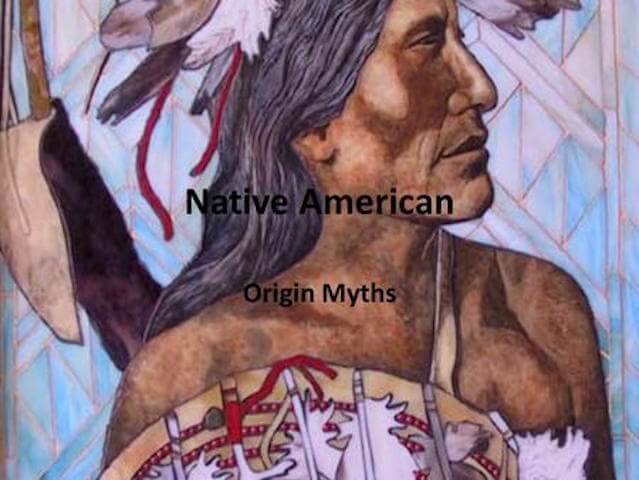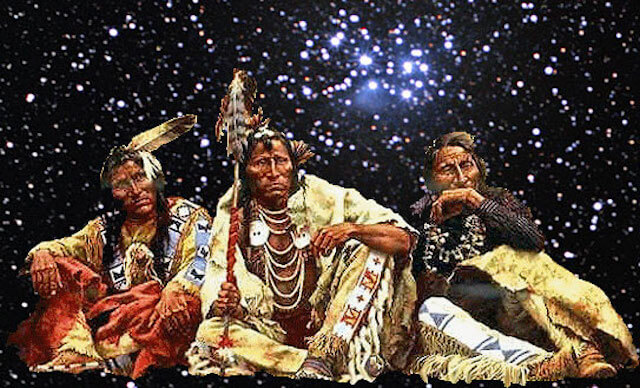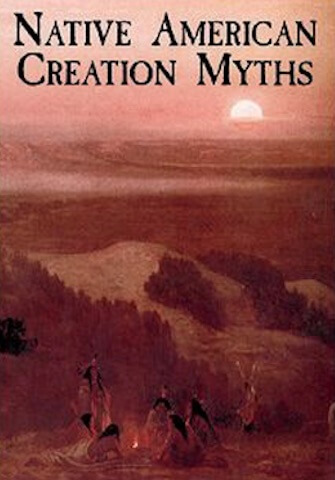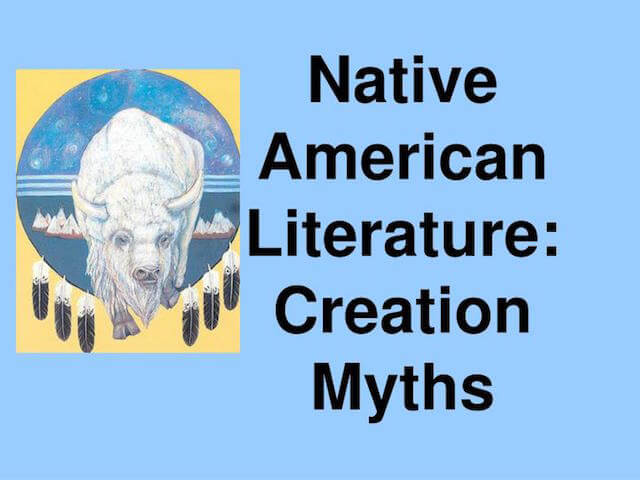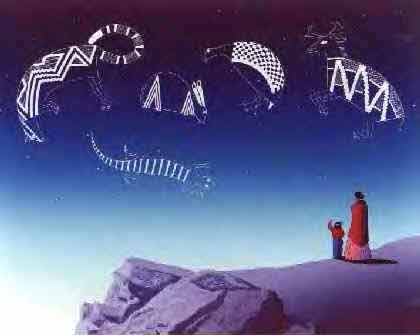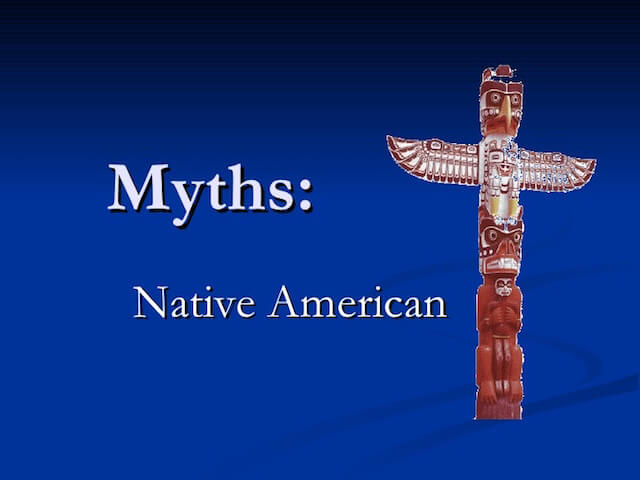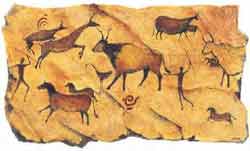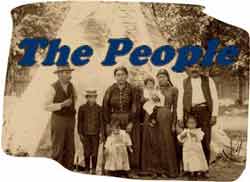To view this page in another language, please click here:
Native American Mythology
The terms legend and folktale are sometimes used interchangeably with myth. Technically, however, these are not the same. How should we distinguish them? Donna Rosenberg, in her book Folklore, Myth, and Legends: A World Perspective, offers some useful guidelines:
A myth is a sacred story from the past. It may explain the origin of the universe and of life, or it may express its culture's moral values in human terms. Myths concern the powers who control the human world and the relationship between those powers and human beings. Although myths are religious in their origin and function, they may also be the earliest form of history, science, or philosophy...A folktale is a story that, in its plot, is pure fiction and that has no particular location in either time or space. However, despite its elements of fantasy, a folktale is actually a symbolic way of presenting the different means by which human beings cope with the world in which they live. Folktales concern people -- either royalty or common folk -- or animals who speak and act like people...
A legend is a story from the past about a subject that was, or is believed to have been, historical. Legends concern people, places, and events. Usually, the subject is a saint, a king, a hero, a famous person, or a war. A legend is always associated with a particular place and a particular time in history.Buffalo Boy
Granted soul, where do I go
I see a world in need of help
Little red buffalo, won't you come with me?
Here I am, newborn child
It's cuz of you I'm buffalo boy
Little red buffalo, hey what do you feel?
Listen to the trees, here's what they say
The land's becoming dangerous
Newborn child, here's what we must do
Teach the old ways, share the knowledge
For all are part of the universe
Newborn child, that's what we must do
Granted soul
Oh, oh, oh
We are the ancestors, returning to you
We are all from the past
Little red buffalo, we were born together
Granted soul, now here we go
Reminding all our relativesCreation/Migration/Origin
Arctic Area
California Area
General Legends
Great Basin Area
Great Plains Area
Northeast Area
Northwest Coast Area
Plateau Area
Southeast Area
Southwest Area
Subarctic Area
World Area
Fables of the Mayas
Gaelic Myths
Kokopelli Legends & Lore
Legends and Folklore of the Northern Lights
Myths from the United Kingdom
Story Robes and Legends
Bear
Buffalo
Coyote
Deer
Eagle
Fox
Grandfather
Jaguar
Rabbit
Raven (Crow)
Skunk
Snake
Wolf
Storytelling Library
AADIZOOKAANAG -- Traditional StoriesAborigine Stories
Australian Legendary Tales
Canku Ota
Cherokee Stories
Cornish Legends
Encyclopedia Mythica
Encyclopedia of Hotc‚k (Winnebago) Mythology
Folk Legends of Japan
Folk Legends of Japan 1
Folklore from around the World
Germanic Myths, Legends, and Sagas
Guam Legends
Guam Legens II
Indian Legends:
(Algonquin, Cherokee, Cheyenne, Chinook, Choctaw, Chumash, Comanche,
Creek, Hopi, Iroquois, Lakota, Lenape, Mohawk, Navajo, Seneca, Sioux)
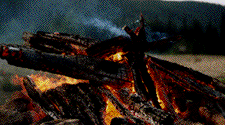
Internet
Sacred Texts
Innu
tipatshimuna (stories)
Irish
Mythology
Legends
Legends
and
Myths
Legends
from
Oban the Knowledge Keeper
Legends,
Stories & Poems
Maya
Stories
Maya
Stories
1
More
Legends
Myths
and
Legends of Our Own Land
Myths
&
Legends
Myths
and
Legends of Ancient Korea
Myths
of Mexico
and Peru
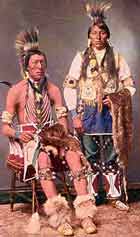
Native
American
Lore
Native
American
Tales
Native
American Oral Traditions
North
American Bigfoot
Legends
Norwegian
Legends
Old
Indian
Legends
Other
Legends
Sacred
Stories
(Africa)
Sioux
Legends
Stories
for
the Seasons
Stories,
Legends
& Folktales
Story
Links
Story
Robes
and Legends (Blackfoot)
Storytelling
of the
North Carolina Indians
Tall
Tales
Thunderhawk
Stories
University
of Virginia Texts
Women
of the Celts in
Myth, Legend and Story
World
Myths
& Legends in Art
Wampum beads, made from several kinds of shell, were highly prized by the Indians who lived along the Atlantic coast. Where beads were laboriously cut from the conch shell and quallog clam, while the thick hinge of the clam provided Pink and purple beads.
Wampum beads were used in various ways. They were strung together to form necklaces and bracelets, or used simply to decorate clothing, weapons and utensils. They also served as a form of money to ransom captives, to pay compensation for crimes and injuries and to reward shamans for their services. Most important of all, they were made into belts and used instead of signatures to confirm area ties and agreements between tribes.
The color of the wampum was also important. White was the emblem of peace and good faith. Purple symbolized death, sorrow and mourning. White beads coloured red were sent as a declaration of war or as an invitation to join a war-party. Combinations of these colours were used to convey messages or to record ceremonies and agreements.
Starlore of Native America
North American Indians tell many stories about the stars - individual stars and groups of stars. Often in these stories, the stars are referred to as "the People of the Sky World."
When the first white people came to the Northwest, Indians of several nations told them about a great bridge of rocks and earth that once spanned the lower Columbia River. When the bridge fell, they said, the rocks made numerous rapids and little waterfalls in the Columbia, near the present city of Hood River. Now the rocks and rapids are covered by the waters above Bonneville Dam.
Other Links
Stories
from the Carribbean
This web site includes information on several
different
topics related to Native American
spirituality,
including some comments on Native American
Origins.
![]() Return to Indigenous Peoples'
Literature
Return to Indigenous Peoples'
Literature
Compiled by: Glenn
Welker
ghwelker@gmx.com
This site has been accessed 10,000,000 times since February 8, 1996.
